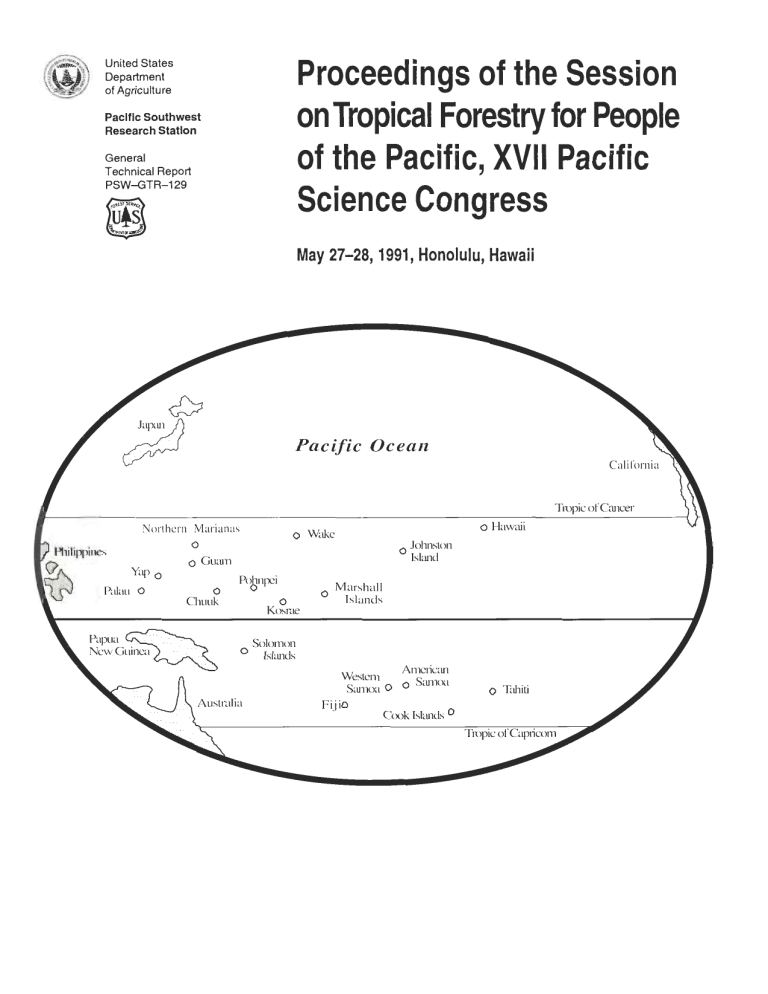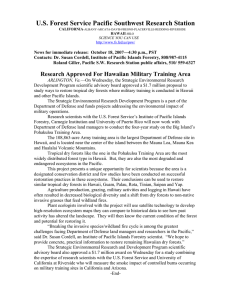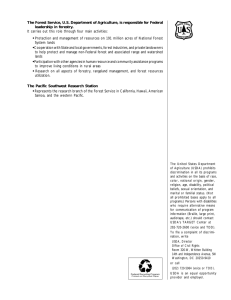Document 11232176

United States
Department of Agriculture
Pacific Southwest
Research Station
General
Technical Report
PSW-GTR-129
Proceedings of the Session on Tropical Forestry for People of the Pacific, XVII Pacific
Science Congress
May 27-28,1991, Honolulu, Hawaii
Pacific O c e a n
Conrad, Eugene C.; Newell, Leonard A., tech. coords. 1992. Proceedings of the session on tropical forestry for people of the Pacific, XVII Pacific Science Congress; May 27-28, 1991; Honolulu, Hawaii. Gen. Tech.
Rep. PSW-GTR-129. Albany, CA: Pacific Southwest Research Station, Forest Service, U.S. Department of
Agriculture; 88 p.
The 17 papers in the Proceedings of the Session on Tropical Forestry for People of the Pacific cover the topics of the USDA Forest Service's tropical forestry research, forestry research in Asia and the Pacific, management of tropical forests for products and energy; forest and wildlife management, the South Pacific Forestry Development
Programme, tropical rainforests of northern Australia, forest resources in New Guinea, management factors affecting forests, forests of East Kalimantan, forest biological diversity, hydrologic effects on forest management, fire management in Central America, soil taxonomy and land evaluation, tropical termites and cuticular hydrocarbons, natural regeneration of Hawaiian forest species, mangrove stands in Micronesia, and introduced weeds of native
Hawaiian forests.
Retrieval Terms: tropical forestry, forestry research, resource management, biological diversity, natural regenera- tion, soil taxonomy, mangroves, tropical termites, weeds, wildlife management. Central America, East Kalimantan,
Hawaii, Micronesia, northern Australia, New Guinea, South Pacific
Technical Coordinators:
C. Eugene Conrad is Director, Institute of Pacific Islands Forestry, Pacific Southwest Research Station; Leonard A.
Newell is Pacific Islands Forester, Pacific Southwest Region; both are with the Forest Service, U.S. Department of
Agriculture, 1151 Punchbowl Street, Room 323, Honolulu, HI 96813.
Publisher:
Pacific Southwest Research Station
Albany, California
(Mailing address: P.O.
Box 245, Berkeley, California 94701-0245
Telephone: 510-559-6300)
January
1992
Proceedings of the Session on Tropical Forestry for People of the Pacific, XVII Pacific
Science Congress
May
27-28,1991,
Honolulu, Hawaii
C. Eugene Conrad and Leonard A. Newell, Technical Coordinatois
Contents
Preface
............................................................................................................................................
Tropical Forestry Research at the USDA Forest Service's Institute of Pacific Islands Forestry
.........
1
C. Eugene Conrad, Jerry A. Sesco
Forestry Research in Asia and Pacific
..............................................................................................
4
Jim Chamberlain, Erin Moore
Management of Tropical Forests for Products and Energy
.............................................................
John I. Zerbe
Holistic Forest and Wildlife Management in Hawaii-Is It Possible?
............................................
15
Michael G. Buck
The South Pacific Forestry Development Programme
....................................................................
17
Tang Hon Tat
Polycyclic Selection System for the Tropical Rainforests of Northern Australia ............................ 21
Management and Utilization of Forest Resources in Papua New Guinea
........................................
26
P.B.
L. Srivastava
Culture and Resource Management: Factors Affecting Forests
......................................................
31
Marjorie C. Falanruw
People and Forests in East Kalimantan
...........................................................................................
Kuswata Kartawinata, Timothy C. Jessup, A.P. Vayda, S. Riswan,
Cynthia Mackie, Nancy E. Peluso
Contents
Forest Biological Diversity Interactions with Resource Utilization
ST.
Mok
Evaluating Long-Term Cumulative Hydrologic Effects of Forest Management:
A Conceptual Approach
.........................................................................................................
47
Robert R. Ziemer
Fire Management in Central America
Andrea L. Koonce, Arrnando Gonzdez-Cabdn
Soil Taxonomy and Land Evaluation for Forest Establishment
......................................................
56
Haruyoshi Ikawa
Cuticular Hydrocarbons for Species Determination of Tropical Termites
.......................................
Michael I. Haverty, Lori J. Nelson, Barbara L. Thorne, Margaret S. Collins,
Johanna P.E.C. Darlington, Marion Page
Role of Decaying Logs and Other Organic Seedbeds in Natural Regeneration of Hawaiian
Forest Species on Abandoned Montane Pasture
.....................................................................
67
Paul G. Scowcroft
Use Classification of Mangrove Areas, Pohnpei, Federated States of Micronesia
..........................
74
Nora N. Devoe
Biological Control of Introduced Weeds of Native Hawaiian Forests
.............................................
84
George P. Markin, Roddy F. Nagata, Donald E. Gardner
USDA Forest Service Gen. Tech. Rep. PSW-129. 1992.
Preface
Tropical forestry for people of the Pacific is a major under- taking. The world's largest ocean is dotted with islands of all sizes, and all but the smallest are home to people. And most have forests of some kind. This Symposium offered a glimpse of the breadth of the values that the people in this huge expanse place on their forests and how they are addressing forest management issues.
What should be the role of forestry research in resolving problems and in meeting the expectations of the region? Tropi- cal forestry in the United States, Australia, Papua New Guinea,
The Federated States of Micronesia, Kalimantan, and Central
America was the principal topic of this Symposium. The impor- tance and difficulties of communication in this vast area was a topic of major concern.
On the day before the Symposium, a small group of partici- pants met to discuss the needs of the forest environment and how to respond to those needs. A major concern was that various people and organizations coordinate with each other, to avoid duplication of work or possible destructive interference with each other or both. The organizers hoped that this group could identify some clear ideas for a resolution that could be supported by the participants of the symposium. The group agreed only that the difficulties in meeting the desires of people who live in the tropical Pacific are similar to those facing people every- where. People everywhere want food, security, shelter, fresh water, and hope for the future of their children. basin-are the best base of knowledge to meet the forestry challenge in the area. This Symposium is one way to begin the process. The papers provide the kind of broad spectrum needed
as a base for action. The first five papers present an overview of research and management issues. The next two papers address issues related to the silviculture of tropical and subtropical forest resources. The relationship of different cultures to forest man- agement is the subject of the next three papers. The remaining papers touch on a broad array of research issues. These include hydrology, fire management, soil taxonomy, insect taxonomy, forest species regeneration, classifying mangroves, and biologi- cal control of forest weeds.
C. Eugene Conrad
Leonard A. Newell
Technical Coordinators
USDA Forest Service Gen.
Tech. Rep. PSW-129. 1992.
. . .
Ill






